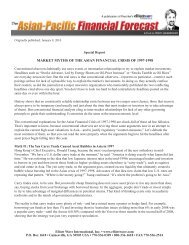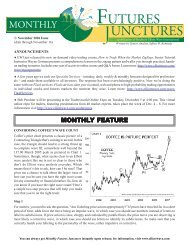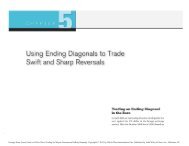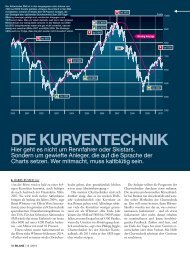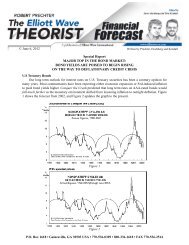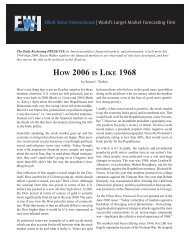060725 EWT Excerpt.PMD - Elliott Wave International
060725 EWT Excerpt.PMD - Elliott Wave International
060725 EWT Excerpt.PMD - Elliott Wave International
Create successful ePaper yourself
Turn your PDF publications into a flip-book with our unique Google optimized e-Paper software.
The <strong>Elliott</strong> <strong>Wave</strong> Theorist -- July 25, 2006August-September 2006 issue© July 25, 2006<strong>Excerpt</strong>ed from the August 2006 <strong>Elliott</strong> <strong>Wave</strong> Theorist exclusively for Club EWI.The Economic FactorThe “Peak Oil” bulls never tire of listing economic forces that will cause oil to go up for decades andcenturies. Never mind that we did not hear about this when oil was $10 a barrel; now it’s fashionable. Butthere is a far more fundamental aspect of economics that the bulls are ignoring. The fourth of theseheadlines hints at what it is:Read that last headline and notice the date it appeared. Did the world go dark? Why not? When aresource becomes scarce and expensive, do people bid it up to infinity and then revert to the Stone Age?No. Why not? High prices provide incentives. Free markets always offer alternatives. Maybe it was“lucky” that men discovered oil under the ground, but had they not done so, they would have developedsome other alternative for providing light. The demand for light is too great for the market to ignore.Let’s forget for the moment that there is in fact a debate about the extent of underground oil fieldsand that some geologists believe they are much more extensive than most people think. Let’s forget thedebates about whether we can grow enough corn to propel automobiles.What people demand is not gasoline, and not even cars, but transportation. A comprehensive trainsystem run on electric power provided by nuclear plants would work just fine. No fuel oil would berequired. And pollution would be nearly eliminated.The only impediments to such a solution are superstition and politics. The free market could buildthe whole system in 30 years if government would let it, just as it built the stunningly successful internetand cell phone networks in just 20 years after the government ended AT&T’s communications monopoly1
The <strong>Elliott</strong> <strong>Wave</strong> Theorist -- July 25, 2006in 1984. Economic forces are reliable, but political ones are not. It is always possible for government tomake energy production impossible, as it nearly does already in the United States with respect toexploration, drilling and refining. Had the free market been allowed to operate, there would be no crisistoday. Even though politics is the only impediment to reasonably priced transportation, the “Peak Oil”devotees never talk about it. They cite natural resource limits and economics. But natural resource limitshave never limited progress; they have only directed it.Even in a transition period, alternatives are generally available. Below you will find a representativesample of media reports about a few of those alternatives, which have appeared remarkably quicklygiven that oil has been rising for only eight years.The market does not respond only from the supply side. Consumers also change their behaviorwhen prices for a particular commodity rise. The reports at the bottom of the next page show some of theways that people have responded to higher gasoline prices. To me the most important one is the last one.There is no law that says everyone has to travel to work. The Internet has made it possible for more andmore people to work from home. Already at my company 25 percent of employees work from home.This is quite a jump from zero just six years ago. Because government roads are such a traffic nightmare(and therefore a colossal time-waster and fuel-waster), the incentive to work from home increases daily.2
The <strong>Elliott</strong> <strong>Wave</strong> Theorist -- July 25, 2006So there are both short-term and long-term forces, working slowly perhaps but relentlessly, againstan ever-rising oil price. It is not impossible for the world to go dark or for people to revert to the StoneAge, but it wouldn’t occur because of economic forces on oil prices; it would occur because of politicsand war, the main immediate forces of setback in human history.Is the Oil Price Really High?Is oil really up in price? I hear you mumble, “What aridiculous question!” But take a look at Figure 19. This isthe price of oil in terms of gold, which is the only basisfor stable money. Unfortunately, governments havedeclared a monopoly on money, driving this good moneyout of circulation. Fortunately, it trades freely on the openmarket, so we can calculate the real-money value ofanything. As you can see in this (updated) graph, the realprice of oil is lower than it was six years ago, despite itsnew all-time high in dollar terms, just registered! Nowlook at Figure 20 on the next page. Yes, it’s true: Even atthis all-time high in dollar terms, the real price of oil hashardly budged for 36 years!How can this be? The answer is that the “record” oilprice is not primarily a function of outrageously expensiveoil but of an outrageously inflated dollar. We are notwitnessing so much a rise in the value of oil but a fall inthe value of the currency in which it trades. Sadly, marketsdo not adjust automatically to inflation. They lie dormantand then surge, which in turn attracts speculators, drivingthe price further than it would otherwise go. Yes, thereFigure 193
The <strong>Elliott</strong> <strong>Wave</strong> Theorist -- July 25, 2006has been a bull market since 1998; <strong>Elliott</strong><strong>Wave</strong> <strong>International</strong> called for a big one, andwe got it. But what made its substantialextent possible was the resistance of the oilprice to inflation for so many years whileinvestors instead drove up the prices ofstocks and bonds. When investors switchedtheir focus, one of the speculativeinvestments they found was oil.Of course, government price-peggingsuppressed the gold price until the early1970s. Therefore, we need to ask whethergold was artificially cheap at that time. Theanswer is: probably not. After the gold pricewas allowed to float, it drifted not up butdown, to below $35 an ounce briefly in 1970before taking off. Had it been wayunderpriced, this slip would not haveoccurred. More than likely, a freely pricedounce of gold would have sold in 1968 asoil did in 1998: cheaply, as investorsfocused on the stock market.Regardless, it is often useful to getmultiple perspectives. Figure 21shows oil from 1970 in terms of ourStable Currency Benchmark (SCB).(For more on the SCB, go towww.StableCurrencyBenchmark.com.)Even this benchmark has been substantiallyinflated, so the overall drift is toward higherprices. Nevertheless, on this basis, the realbull market for oil occurred in the 1970s,when oil rose ten times in value. The latestprice is not much above that in 1981 aquarter-century ago! It has a bit more thanquadrupled since 1998, though, which isthe rise we anticipated and the one that hasgotten people so excited.So an investor must ask himself, “AmI speculating on the value of oil or the valueof a currency?” If it’s the latter, you hadbetter have a basis for forecasting it, andyou should ask yourself whether a “profit”in a depreciating currency is really a profitat all. If not, there are other, safer ways tomaintain the purchasing power of yourwealth (see Part 2 of Conquer the Crash).Figure 20Figure 214
The <strong>Elliott</strong> <strong>Wave</strong> Theorist -- July 25, 2006Back to <strong>Elliott</strong> <strong>Wave</strong>sO.K., now we can talkintelligently about the <strong>Elliott</strong>wave outlook. The only chartwith which we are concernedis the oil/dollar chart, becausethat was the basis for EWI’soriginal forecast, and that isthe basis of the market’sextreme psychology. If youcare about the value of oil interms of real money (gold),then I wouldn’t worry toomuch about it. Our forecast,then involves a combinationof the economic and financialvalues of oil and the financialvalue (the only value) of thedollar, all in one package.Figure 22 updates thelong term picture. You can seethe outcome of the forecast for“new historical highs” issuedat the bottom of wave IV.Figure 22From this perspective, the bigoil zoom of recent years is just a normal wave. Figure 23 shows the detail in the oil/dollar picture from1969 to March 2006, along with the forecast I showed at the time. As you can see, oil had traced out aclear five waves within wave III, which took place mostly in the 1970s, so we would expect it also toFigure 235
The <strong>Elliott</strong> <strong>Wave</strong> Theorist -- July 25, 2006Figure 24trace out five waves within wave V. As I saw it then, wave (5) of 3 and wave 5 were the only remainingupward waves left to go. My conclusion on March 16 was as follows:“The time to have speculated in oil was 1998, 2001 at the latest. From here on out will just be a frustratingtopping process involving a substantial interim setback. And when it’s over, oil will go down for a long, longtime because it will have ended five waves up from 1933 and will require a correspondingly long and largeretracement. There are better places to make money.”Figure 24 updates this picture. Today oil appears to be finishing wave (5) of 3, and possibly wave5 if the triangle count (see e label in Figures 9 and 12) is correct. Either way, it’s the end of a Fibonacci5-year advancing wave from 2001. Psychology is certainly heating up again. The oil price, which reached$78.40 intraday ($77.03 close) on Friday, July 14 is making headlines. A Newsweek cover hittingnewsstands that very weekend (forward-dated to July 24) trumpets “Meltdown” in the Middle East andpromises to tell us “What [it] Means for…The Price of Oil.” The column quotes an analyst saying, “Ifanother hurricane blows through the Gulf of Mexico and damages rigs and refineries, that will sendprices way up.” Never mind the incredibly low odds of such an occurrence. The fact is that the last timea hurricane blew through the Gulf of Mexico and damaged rigs, the event coincided with a top in prices,not a bottom. There was no triggering event at the bottom; there never is. Naturally, the galvanizing eventthat got the public to buy oil futures trapped them right at a peak. But who cares about such facts? Formost analysts, assumption trumps reality. Now there has been another galvanizing event: a blow-up ofhostilities in the Middle East. Most economists cite the event as bullish for oil prices. Based on whathappened after Katrina, what do you think?In the wake of this new excitement, the NYMEX, where energy futures trade, has just announcedthat it will sell $250m. worth of stock in an initial public offering, “as record oil prices and trading sparksinterest in energy exchanges.” Exchange owners are not dumb. They didn’t offer shares of the exchangewhen oil was in the doldrums. They prefer to sell shares to the public as close to a top in prices andtrading volume as they can get.6
The <strong>Elliott</strong> <strong>Wave</strong> Theorist -- July 25, 2006Today, right as we go to press, what may be the shrillest report yet about oil in the mainstream presshas appeared in a major magazine. Our local newspaper reports:As you can see, myriad signs point strongly to a selling opportunity in oil. Although a spike high isnot impossible, and another high for wave 5 could be in the offing later, the psychological environmentdemands that we continue to pay attention to the original wave interpretation labeling wave IV a triangle.That count implies that the final top is occurring now, per the “Alt.” line in Figures 23 and 24. Either way,a setback of at least Primary degree, if not a multi-year bear market, is due now. The danger of holding oilinvestments at this time far outweighs the potential reward. If a spike high becomes likely, or if monthsfrom now the waves imply another rally, you can hear about it on our Oil Specialty Service. But untilsuch a time, stay away from the long side.An elaborate direct-mail advertisement that reached my mailbox on July 13 (the day before the latestoil peak) spends the equivalent of 24 pages to convince its readers that a soaring oil price is “In-ev-i-table.”One should pause, though, when the writer admits, “How did we NOT see this coming?” If someonedidn’t see it coming, should we rely on him to see it going? Our Oil Specialty Service (http://www.elliottwave.com/wave/SSEnergy), with daily coverage, and Global Market Perspective (http://www.elliottwave.com/wave/GMPclub), published monthly, have been confidently tracking and forecastingthe oil market. If you want to play these waves, short or long, by all means look into these services.And by the Way...Despite economists’ repeated assertions, you can’t use oil prices to explain (much less predict) thestock market. Headlines like these appear all the time.As you can see in Figure 25, however, oil and stocks have trended mostly in the same direction for7
The <strong>Elliott</strong> <strong>Wave</strong> Theorist -- July 25, 2006more than three years, so these headlines arebackward. A falling oil price probably won’t be bullishfor stocks, either. When deflation takes hold, they willprobably both go down together. Investors will saythe drop in oil is bullish for the economy, but in factcoincident declines would be a harbinger of depression.So yes, you can be bearish on stocks and oil at thesame time. But don’t depend on that relationshipcontinuing forever. The resumption of the negativesocial mood trend (see next section) will also bring anincrease in warring, which could disrupt supplies, spurgovernment rationing or otherwise affect the economicportion of the oil pricing dynamic. As Figure 26 shows,there is no consistent correlation between stock andoil prices over time. That’s the market’s job: to throwa snowball in the air to catch your attention so thatwhen you look up it can smack you in the jaw withanother one. Don’t fall for it.Figure 25Figure 268




